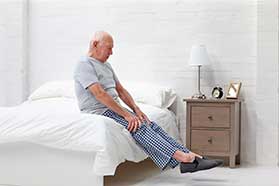Peripheral Artery Disease Treatment in Beverly Hills, CA

Peripheral artery disease (PAD), also known as peripheral vascular disease (PVD), is a painful condition that involves the narrowing of your arteries and diminished blood flow to your muscles in your legs due to the build-up of plaque caused by atherosclerosis . The plaque is a combination of cholesterol, fat, calcium, fibrous tissue and other elements in your blood. When the plaque breaks open, it causes a blood clot to form. The buildup of plaque or blood clots are what narrows the arteries.
Though PAD most commonly affects your calves, buttocks, hips and thighs, it can also affect your stomach, arms and head. The narrow arteries restrict your blood flow, causing your extremities to not receive enough oxygen from your blood when you need it. PAD is generally most noticeable when you try to walk or exercise because your body cannot keep up with the demand for oxygen-rich-blood to the muscles in your legs, arms or stomach. When you stop to rest, the pain may subside.
To consult with a cardiovascular health specialist in Beverly Hills that can make safe and effective recommendations to help you with your peripheral artery disease treatment, call (424) 365-1800 or contact Vitality Integrative Medicine online.
Peripheral Artery Disease Causes
People who regularly use tobacco are at a much higher risk of developing peripheral artery disease. Other conditions that can cause PAD include:
- High blood pressure
- High cholesterol
- Lack of exercise
- Diabetes
- Obesity
- Being over 50 years old and having a history of smoking
Peripheral Artery Disease Symptoms
Peripheral artery disease symptoms are most often noticed when you engage in more physical activity than what you might typically do on an average day. The pain may stop after you rest for a few minutes. The area where you feel the pain depends on where the arteries that are clogged or narrowed are located. The pain can range from mild to severe. Some of the symptoms of PAD include:
- Pain and /or cramping in your calf
- Pain in your hip, buttock, thigh and / or foot
- Leg numbness or weakness
- Legs and / or feet that are colder than your arms
- Sores on your toes, legs or feet that don't heal
- Hair loss or slow growing hair on your legs
- Toenails that don't grow quickly
- Shiny skin on your legs
- Weak pulse in your legs or feet
- Male erectile dysfunction
Peripheral Artery Disease Diagnosis & Treatment
Peripheral artery disease is not necessarily easy to diagnose. The ease of the diagnosis is dependent on the person and the extent of the condition. Your healthcare provider will want to begin with a physical exam that may include checking your pulse, taking your blood pressure and listening to your arteries with a stethoscope. Your healthcare provider may also choose to perform:
- An ankle-brachial index test (ABI) to compare the blood pressure in your ankle and arm
- A Doppler ultrasound to check the blood flow through your blood vessels and check for blocked arteries
- Blood test to check your cholesterol, triglycerides and for diabetes
- An angiography test that injects contrast material (a type of dye) into your blood vessels to check your blood flow through your arteries in real time via various imaging techniques
Peripheral vascular disease treatment can be fairly easily managed with the proper diet and exercise, though in some cases, your healthcare provider may also choose to include prescription medication that thins your blood or improves your blood flow. Your healthcare provider will also likely recommend that you refrain from smoking if you are a smoker. If large areas of the artery in your leg are blocked, surgery may be required such as an atherectomy to remove plague or an angioplasty to improve blood flow.
Request more information about peripheral artery disease treatment today. Call (424) 365-1800 or contact Vitality Integrative Medicine online.
Vitality Integrative Medicine
Address
4849 Van Nuys BlvdSuite 104
Sherman Oaks, CA 91403
(424) 365-1800
www.vitalityintegrative.com
Hours
Mon:
8:00 am - 6:00 pm
Tue:
8:00 am - 6:00 pm
Wed:
8:00 am - 6:00 pm
Thu:
8:00 am - 6:00 pm
Fri:
8:00 am - 6:00 pm
Sat:
8:00 am - 12:00 pm
